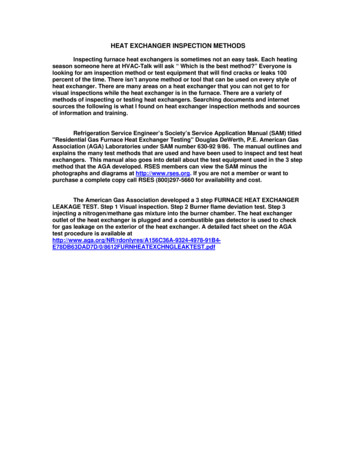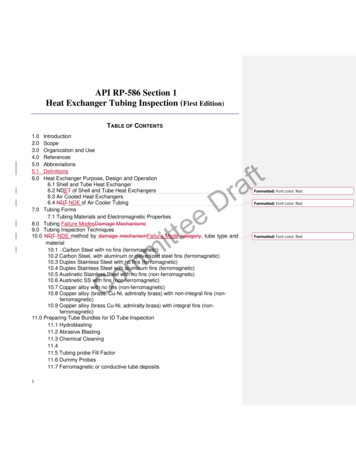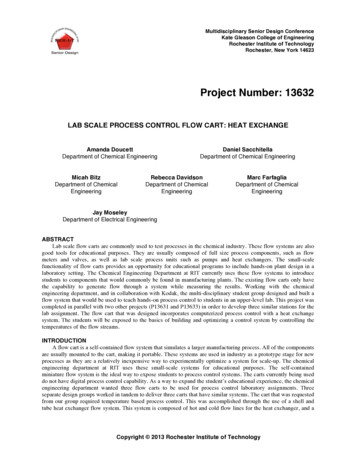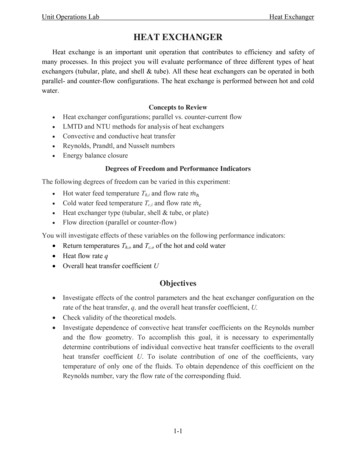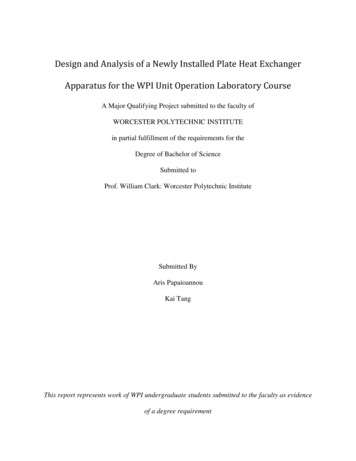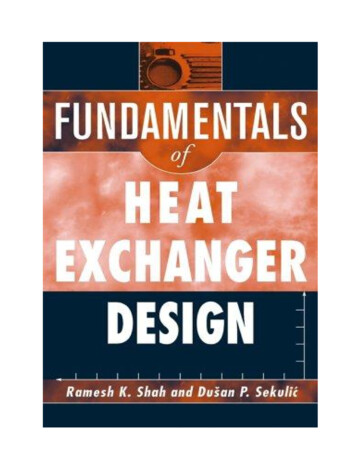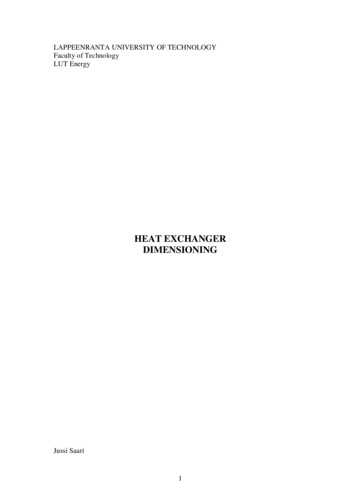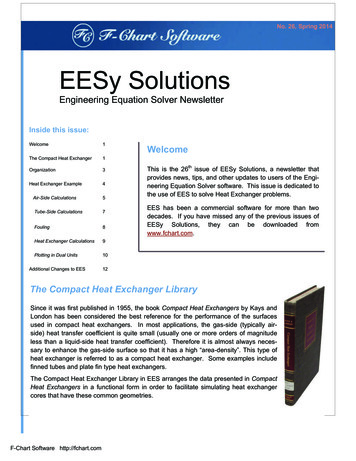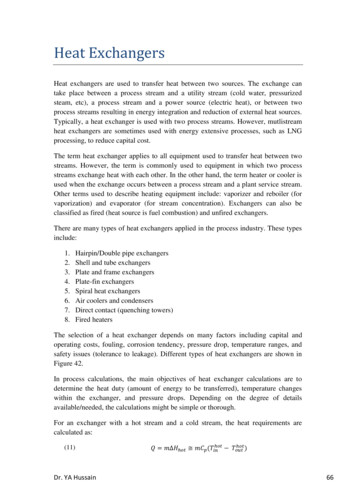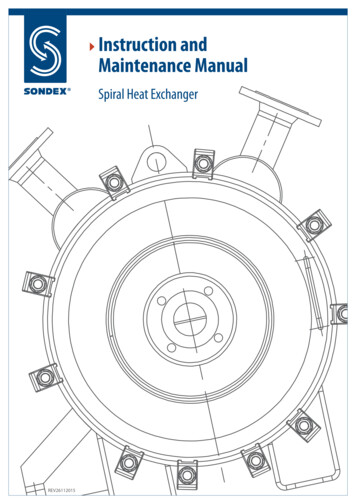
Transcription
Lectures 19 Applied Heat Transfer CM311012/3/2019CM3110Transport IPart II: Heat TransferApplied Heat Transfer:Heat Exchanger Modeling,Sizing, and DesignProfessor Faith MorrisonDepartment of Chemical EngineeringMichigan Technological University1 Faith A. Morrison, Michigan Tech U.Applied Heat TransferBefore turning to radiation (last topic) wewill discuss a few practical applicationsHow can we use Fundamental Heat Transfer tounderstand real devices like heat exchangers?heat transferfluidhotprocess streamcoldheat exchangerprocess streamless coldheat transferfluidless hot2 Faith A. Morrison, Michigan Tech U.1
Lectures 19 Applied Heat Transfer CM311012/3/2019Applied Heat TransferThe Simplest Heat Exchanger:Double‐Pipe Heat exchanger ‐ counter currentT1 less hotT1T2coldless coldThe heat transfer from theoutside to the inside is justheat flux in an annular shellT2 hot3 Faith A. Morrison, Michigan Tech U.Applied Heat TransferExample 4: Heat flux in a cylindrical shellMaybe we can use heat transfercoefficient to understand forcedconvection heat exchangers. . .BUT . . .Assumptions: long pipe steady state k thermal conductivity of wall h1, h2 heat transfer coefficients at 𝑅 and 𝑅Cooler fluidat Tb2R1 rR2Hot fluid atTb14 Faith A. Morrison, Michigan Tech U.2
Lectures 19 Applied Heat Transfer CM311012/3/2019Applied Heat TransferBUT: The temperature difference between the fluid andthe wall varies along the length of the heat exchanger.The Simplest Heat Exchanger:Double‐Pipe Heat exchanger ‐ counter currentT1 T , outer bulk temperatureT , inner bulk temperatureless hotT1T2coldless cold xLT2 hotHow can we develop a model so thatwe can use the concept of ℎ tocharacterize heat exchangers?Newton’slaw ofcoolingassumes aconstant h.5 Faith A. Morrison, Michigan Tech U.Applied Heat TransferLet’s look at the solution for radial conduction in an annulusExample 4: Heat flux in a solid cylindrical shellSolution:qr c1 A rcT 1 ln r c2kFlux is notconstantBoundary conditions?6 Faith A. Morrison, Michigan Tech U.3
Lectures 19 Applied Heat Transfer CM311012/3/2019Applied Heat TransferExample 4: Heat flux in a cylindrical shell, Newton’slaw of cooling boundary ConditionsResults: Radial Heat Flux in a Solid Cylindrical Shell𝑇𝑇𝑇𝑇1ℎ 𝑅𝑞𝐴1ℎ 𝑅1ℎ 𝑅1ℎ ���𝑘1𝑟1ℎ 𝑅7 Faith A. Morrison, Michigan Tech U.Applied Heat TransferCoolerfluid at Tb2Example 4: Heat flux in a solid cylindrical shell Solution forHeat Flux:R1R2Hot fluid atTb1𝑞𝐴1ℎ 𝑅𝑇𝑇1𝑅ln𝑅𝑘Calculate Total Heat flowthrough any chosen 𝒓:𝑄r𝑞2𝜋𝑟𝐿𝐴1ℎ 𝑅(including 𝑟𝑇1ℎ 𝑅1𝑟𝑇1𝑅ln𝑅𝑘𝑅 and 𝑟𝑅 )2𝜋𝐿1ℎ 𝑅Note that total heat flow isproportional to bulk Δ𝑇 and(almost) area of heat transfer8 Faith A. Morrison, Michigan Tech U.4
Lectures 19 Applied Heat Transfer CM311012/3/2019Applied Heat TransferCoolerfluid at Tb2 Total Heat flow through any chosen 𝒓:(including 𝑟𝑅 and 𝑟𝑞2𝜋𝑟𝐿𝐴𝑄R1R2Hot fluid atTb1𝑅 )𝑇1ℎ ���1ℎ 𝑅Note that total heat flow is proportional to bulk Δ𝑇 and (almost)area of heat transfer9 Faith A. Morrison, Michigan Tech U.Applied Heat Transfer—Define Overall Heat-Transfer Coefficient, U T driving temperature differenceDo weuse inneror outerarea?10 Faith A. Morrison, Michigan Tech U.5
Lectures 19 Applied Heat Transfer CM311012/3/2019Applied Heat TransferOverall heat transfer coefficients in pipeArea must bespecified when𝑼 is reportedQ U1 A1 T1𝑅1ℎ 𝑅1 𝑅ln𝑘 𝑅1ℎ 𝑅2 𝜋𝑅 𝐿 𝑇𝑇2 𝜋𝑅 𝐿 𝑇𝑇Q U 2 A2 T1𝑅1ℎ 𝑅1 𝑅ln𝑘 𝑅1ℎ 𝑅11 Faith A. Morrison, Michigan Tech U.Applied Heat TransferHeat flux in a cylindrical shell: 𝑄𝑈𝐴 𝑇𝑇But, in an actual heat exchanger, 𝑇 and 𝑇along the length of the heat exchangerheat transferfluidvaryhotprocess streamprocess streamheat exchangercoldless coldWhat kind of average𝚫𝑻 do we use?heat transferfluidless hot12 Faith A. Morrison, Michigan Tech U.6
Lectures 19 Applied Heat Transfer CM311012/3/2019Applied Heat TransferThe Simplest Heat Exchanger:Double‐Pipe Heat exchanger ‐ counter currentT1 T , outer bulk temperatureT , inner bulk temperatureless hotT1T2coldless cold xT2 LhotWe will do an open‐system energybalance on a differential section todetermine the correct averagetemperature difference to use.13 Faith A. Morrison, Michigan Tech U.Applied Heat TransferT1 The Simplest Heat Exchanger:Double‐Pipe Heat exchanger ‐ counter currentT1𝑇T2coldAnother way of looking at it:𝑚less hotless coldT2 System𝑸𝑇𝑄14 Faith A. Morrison, Michigan Tech U.7
Lectures 19 Applied Heat Transfer CM311012/3/2019T1 The Simplest Heat Exchanger:Double‐Pipe Heat exchanger ‐ counter currentT1Another way of looking at it:Can do three balances:𝑚1. Balance onthe inside𝑇systemless hotT2coldless coldT2 System𝑸𝑇𝑄15 Faith A. Morrison, Michigan Tech U.T1 The Simplest Heat Exchanger:Double‐Pipe Heat exchanger ‐ counter currentT1Another way of looking at it:Can do three balances:𝑚1. Balance onthe inside𝑇system2. Balance onthe outsidesystem𝑚𝑇𝑄less hotT2coldless coldT2 ��𝑄16 Faith A. Morrison, Michigan Tech U.8
Lectures 19 Applied Heat Transfer CM311012/3/2019T1 The Simplest Heat Exchanger:Double‐Pipe Heat exchanger ‐ counter currentless hotT1Another way of looking at it:T2coldless coldT2 Can do three balances:𝑚1. Balance onthe inside𝑇system2. Balance onthe outsidesystem𝑚3. utsideSystem𝑄𝑸𝑇𝑄17 Faith A. Morrison, Michigan Tech U.T1 The Simplest Heat Exchanger:Double‐Pipe Heat exchanger ‐ counter currentless hotT1Another way of looking at it:T2coldless coldT2 tsideSystem𝑸𝑇hotWe can do: a macroscopic balancesover the entire heatexchanger, or a pseudo microscopicbalance over a slice ofthe heat exchanger𝑄18 Faith A. Morrison, Michigan Tech U.9
Lectures 19 Applied Heat Transfer CM311012/3/2019T1 The Simplest Heat Exchanger:Double‐Pipe Heat exchanger ‐ counter currentless hotT1Another way of looking at it:T2coldless coldT2 𝑚𝑇hot𝑚InsideSystem𝑇We can do: a macroscopic balancesover the entire heatexchanger, or a pseudo microscopicbalance over a slice ofthe heat exchanger𝑸𝑚𝑚OutsideSystem𝑇𝑇All the details of the algebra are here:www.chem.mtu.edu/ fmorriso/cm310/double pipe.pdf𝑄𝑸𝑄19 Faith A. Morrison, Michigan Tech U.Applied Heat TransferPseudo Microscopic Energy Balance on a slice of the heat exchangerOpen system energy balance on a differential �INSIDEBALANCErecall: Δ is out-in20 Faith A. Morrison, Michigan Tech U.10
Lectures 19 Applied Heat Transfer CM311012/3/2019Applied Heat TransferPseudo Microscopic Energy Balance on a slice of the heat exchangerΔ𝐻𝑄Δ𝑄INSIDEBALANCE,recall: Δ is out-in21 Faith A. Morrison, Michigan Tech U.Applied Heat TransferPseudo Microscopic Energy Balance on a slice of the heat exchangerOVERALLBALANCEAdiabatic HeatExchanger – Qin 0Δ𝐸Δ𝐸Δ𝐻0Δ𝐻𝑄𝑊,22 Faith A. Morrison, Michigan Tech U.11
Lectures 19 Applied Heat Transfer CM311012/3/2019Applied Heat TransferThis expression characterizes therate of change of heat transferredwith respect to distance down theheat exchanger23 Faith A. Morrison, Michigan Tech U.T1 The Simplest Heat Exchanger:Double‐Pipe Heat exchanger ‐ counter currentless hotT1Result of inside sult of outside balance:𝑑𝑄𝑑𝑥𝑑𝑄𝑑𝑥𝑑𝑄 𝑑𝑥less coldT2 hotSolve for temperaturederivatives, and ��Result of overall balance:𝑑𝑄𝑑𝑥T2coldThisdependson 𝑇𝑇11𝑚𝐶𝑚𝐶𝑑𝑇′ 𝑑𝑇𝑑𝑥 𝑑𝑥𝑑 𝑇𝑇𝑑𝑥All the details of the algebra are here:www.chem.mtu.edu/ fmorriso/cm310/double pipe.pdf24 Faith A. Morrison, Michigan Tech U.12
Lectures 19 Applied Heat Transfer CM311012/3/2019Analysis of double-pipe heat exchangerT (x)T12 T T T2Rate of change of heattransferred with respect todistance down the heatexchangerT1 T1LQuestion: How can we writeAnswer:Driving forcefor heattransferdQinin terms of T ' T ?dxDefine an “overall” heattransfer coefficient, U25 Faith A. Morrison, Michigan Tech U.Analysis of double-pipe heat exchanger𝑑 𝑇𝑇𝑑𝑥𝑑𝑄𝑑𝑥Want to integrate tosolve for 𝑇 𝑇,1𝑚𝐶1𝑚𝐶but this is a function of 𝑇T (x)T12 T T T2T1 T1L𝑇For the differential slice of the heatexchanger that we are considering(modeling our ideas on Newton’s lawof cooling),𝑑𝑄𝑑𝐴? 𝑇𝑇26 Faith A. Morrison, Michigan Tech U.13
Lectures 19 Applied Heat Transfer CM311012/3/2019Analysis of double-pipe heat exchangerFor the differential slice of the heatexchanger that we are considering (modelingour ideas on Newton’s law of cooling),𝑑𝑄𝑑𝐴𝑑𝑄𝑑𝑄𝑑𝑥? 𝑇𝑇𝑈 𝑑𝐴 𝑇𝑇𝑈 2𝜋𝑅𝑑𝑥 𝑇𝑈 2𝜋𝑅 𝑇𝑇We can writeinterms of 𝑇𝑇 if wedefine an “overall”heat transfercoefficient, 𝑈𝑇This is the missing piece that we needed.27 Faith A. Morrison, Michigan Tech U.Analysis of double-pipe heat exchanger𝑑 �� 𝑇𝑇𝑑𝑥𝑑 𝑇𝑇2𝜋𝑅𝑈 ��𝑈 𝑇𝑇1𝐶 𝑚𝑇11𝐶 𝑚𝐶 𝑚1𝐶 𝑚𝑑𝑥28 Faith A. Morrison, Michigan Tech U.14
Lectures 19 Applied Heat Transfer CM311012/3/2019Analysis of double-pipe heat exchanger𝑑 𝑇𝑇𝑇𝑇2𝜋𝑅𝑈Φ 𝑇lnΦ1𝐶 𝑚𝐶 𝑚𝑇𝑑𝑥(we’ll assume𝑈 is constant)1𝐶 𝑚1𝛼 2𝜋𝑅𝑈𝐶 𝑚𝑑ΦΦ𝑑ΦΦ1𝛼 𝑑𝑥𝛼𝑑𝑥𝛼 𝑥 constantΦ Φ 𝑒B.C:𝑥 0, 𝑇𝑇𝑇𝑇29 Faith A. Morrison, Michigan Tech U.Analysis of double-pipe heat exchangerT1 less hotT1T2coldless coldTemperature profile in adouble‐pipe heat exchanger:T T e 0 xT1 T1T2 hot 11 Cˆ m Cˆ m p p 0 2 RU 30 Faith A. Morrison, Michigan Tech U.15
Lectures 19 Applied Heat Transfer CM311012/3/2019Analysis of double-pipe heat exchangerT1 x 0 L T T e L T1 T1less hotT1T2coldless cold𝛼 𝐿T2 2𝜋𝑅𝐿𝑈hot1201𝐶 𝑚1𝐶 𝑚1T’o2 RL 15.4m 20.8m C p' 6 kW / K0.780T, T' ( C)U 300 W / mK0.9100mC p 3 kW / 40.60.81x/LDistance down the heat exchangerNote that thetemperaturecurves are notlinear.31 Faith A. Morrison, Michigan Tech U.Analysis of double-pipe heat exchangerTemperature profile in a double‐pipe heat exchanger:T T e 0 xT1 T1 11 Cˆ m Cˆ m p p 0 2 RU Useful result, but what we REALLY want is an easy wayto relate 𝑄𝑖𝑛, 𝑜𝑣𝑒𝑟𝑎𝑙𝑙 to inlet and outlet temperatures.At the exit: 𝑥𝐿, 𝑇𝑇𝑇𝑇 1 T2 T2 1 ln U 2 RL Cˆ m Cˆ m T1 T1 p p32 Faith A. Morrison, Michigan Tech U.16
Lectures 19 Applied Heat Transfer CM311012/3/2019Analysis of double-pipe heat exchanger 1 T2 T2 1 URL ln 2 Cˆ m Cˆ m T1 T1 p p 𝑄The 𝑚𝐶 𝑝 terms appear in the overallmacroscopic energy balances. We cantherefore rearrange this equation byreplacing the 𝑚𝐶 terms with 𝑄 :𝑄𝑈𝐴𝑇𝑇lntotal heattransferred inexchanger𝑇𝑇 𝑚𝐶 𝑇1𝑇𝑇𝑇𝑄𝑚𝐶𝑄𝑚𝐶 𝑇𝑇 𝑄𝑚𝐶1𝑇𝑇𝑇𝑇average temperaturedriving force Faith A. Morrison, Michigan 33Tech U.T1 Analysis of double-pipe heat exchangerless hotT1FINAL RESULT:T2cold T T T2 T2 Q U 2 RL 1 1 T T ln 1 1 T2 T2 AQ UA Tlm𝑇𝑇less coldT2 hot Tlm log‐mean temperaturedifference Tlm is the correct average temperature to use for the overall heat‐transfer coefficients in a double‐pipe heat exchanger.34 Faith A. Morrison, Michigan Tech U.17
Lectures 19 Applied Heat Transfer CM311012/3/2019T1 Analysis of double-pipe heat exchangerT1FINAL RESULT:𝑄less hotT2cold𝑈𝐴Δ𝑇Δ𝑇Δ𝑇lnΔ𝑇Q UA Tlmless coldT2 hot Tlm log‐mean temperaturedifference Tlm is the correct average temperature to use for the overall heat‐transfer coefficients in a double‐pipe heat exchanger.35 Faith A. Morrison, Michigan Tech U.Analysis of double-pipe heat exchangerExample: Heat Transfer in a Double‐PipeHeat Exchanger: Geankoplis 4 ed. 4.5‐4thWater flowing at a rate of 13.85 kg/s is to be heated from 54.5 to87.8oC in a double‐pipe heat exchanger by 54,430 kg/h of hot gasflowing counterflow and entering at 427oC (𝐶 𝑝𝑚 1.005 𝑘𝐽/𝑘𝑔 𝐾).The overall heat‐transfer coefficient based on the outer surface is Uo 69.1 W/m2 K. Calculate the exit‐gas temperature and the heattransfer area needed.36 Faith A. Morrison, Michigan Tech U.18
Lectures 19 Applied Heat Transfer CM311012/3/2019Analysis of double-pipe heat exchanger4.254.24Cp, water kJ/kg K4.23y 0.0006x 4.15042R 00oT ( C)37 Faith A. Morrison, Michigan Tech U.Summary:Double‐Pipe Heat Exchanger – the driving force for heat transfer changes along thelength of the heat xchangerFor example,T1 300o C T T T x x8 340C oT2 900 CT1 50 Co T T T x x1 250C o260 270 280 300 315 328 T (x)The correct average driving force forthe whole xchanger is the log‐meantemperature differenceT2 430o C Tlm38 Faith A. Morrison, Michigan Tech U.19
Lectures 19 Applied Heat Transfer CM311012/3/2019Optimizing heat exchangersOptimizing Heat ExchangersT1 double-pipe:T1T2Q UA TlmT2 To increase Q appreciably, we must increase A, i.e. RiBut: only small increases possible increasing Ri decreases h39 Faith A. Morrison, Michigan Tech U.Optimizing heat exchangers1-1 Shell and Tube Heat Exchanger(Same as double pipe H.E.)1 shell1 tube1-2 Shell and Tube Heat ExchangerGeankoplis 4th ed.,p2921 shell2 tube40 Faith A. Morrison, Michigan Tech U.20
Lectures 19 Applied Heat Transfer CM311012/3/2019Optimizing heat exchangersCross Baffles in Shell-and-Tube Heat Exchangers41 Faith A. Morrison, Michigan Tech U.Optimizing heat exchangersAnd other more complex arrangements:2 shell4 tube42 Faith A. Morrison, Michigan Tech U.21
Lectures 19 Applied Heat Transfer CM311012/3/2019Optimizing heat exchangersFor double-pipe heat exchanger:Q UA TlmFor shell-and-tube heat exchangers:Q UA Tlm FT Tmcalculated correction factor (obtain fromexperimentally determined charts)correct mean temperaturedifference for shell-and-tubeheat exchangers43 Faith A. Morrison, Michigan Tech U.Optimizing heat exchangers1-2 Shell and Tube H.E.FTShell-and-Tube HeatExchangersFT,min 0.75(1-1 exchanger, FT 1)Efficiency is low when 𝐹is below 𝐹 ,Thi hot, inTho hot, outTci cold, inTco cold, out2-4 Shell and Tube H.E.FT,min 0.75Geankoplis 4th ed.,p29544 Faith A. Morrison, Michigan Tech U.22
Lectures 19 Applied Heat Transfer CM311012/3/2019Heat Exchanger DesignHeat Exchanger DesignTo calculate Q, we need both inlet and outlet temperatures:Q UA Tm UA FT Tlm T1 𝑄T1𝑈𝐴T2Δ𝑇Δ𝑇Δ𝑇lnΔ𝑇T2 What if the outlet temperatures are unknown?i.e. the design/spec problem.45 Faith A. Morrison, Michigan Tech U.Heat Exchanger DesignExample Problem:How will this heat exchanger perform?Water flowing at a rate of 0.723 𝑘𝑔/𝑠 enters the inside of acountercurrent, double-pipe heat exchanger at 300.K andis heated by an oil stream that enters at 385 𝐾 at a rate of3.2 𝑘𝑔/𝑠. The heat capacity of the oil is 1.89 𝑘𝐽/𝑘𝑔𝐾, andthe average heat capacity of the water of the temperaturerange of interest is 4.192 𝑘𝐽/𝑘𝑔𝐾. The overall heattransfer coefficient of the exchanger is 300. 𝑊/𝑚 𝐾, andthe area for heat transfer is 15.4 𝑚 . What is the totalamount of heat transferred?46 Faith A. Morrison, Michigan Tech U.23
Lectures 19 Applied Heat Transfer CM311012/3/2019Heat Exchanger DesignT1 Example Problem:How will this heat exchanger perform?T1T2T2 Water flowing at a rate ofenters the inside of acountercurrent, double-pipe heat exchanger at 300.K andis heated by an oil stream that enters atat a rate of. The heat capacity of the oil is, andthe average heat capacity of the water of the temperaturerange of interest is. The overall heattransfer coefficient of the exchanger is, andthe area for heat transfer is. What is the totalamount of heat transferred?You try.47 Faith A. Morrison, Michigan Tech U.Heat Exchanger DesignExample Problem:How will this heat exchanger perform?To calculate unknown outlet temperatures:Procedure:1. Guess Q2. Calculate outlet temperatures3. Calculate Δ𝑇4. Calculate Q5. Compare, adjust, repeat48 Faith A. Morrison, Michigan Tech U.24
Lectures 19 Applied Heat Transfer CM311012/3/2019Heat Exchanger DesignExample Problem:How will this heat exchanger perform?UAT 1Tprime 2m waterm' oilcp watercp oil0.315.43003850.7233.24.1921.89kW/m 2Km 2KKkg/skg/skJ/kgKkg/kgK1Guess QT 2Tprime 1Delta leftDelta RightDeltaTlmQ new100333368685260276.5kJ/sKKKKKkW2Guess QT 2Tprime 1Delta leftDelta RightDeltaTlmQ new200366352521933151.4kJ/sKKKKKkW3Guess QT 2Tprime 1Delta leftDelta RightDeltaTlmQ new150349360603647216.1kJ/sKKKKKkW4Guess QT 2Tprime 1Delta leftDelta RightDeltaTlmQ new170356357572941191.0kJ/sKKKKKkW5Guess QT 2Tprime 1Delta leftDelta RightDeltaTlmQ new180359355552639178.1kJ/sKKKKKkW6Guess QT 2Tprime 1Delta leftDelta RightDeltaTlmQ fecExample.xlsx49 Faith A. Morrison, Michigan Tech U.Heat Exchanger DesignExample Problem:How will this heat exchanger perform?This procedure can be sped upconsiderably by the use of the concept ofUAT 1Tprime 2m waterm' oilcp watercp oil0.315.43003850.7233.24.1921.89kW/m 2Km 2KKkg/skg/skJ/kgKkg/kgK1Guess QT 2Tprime 1Delta leftDelta RightDeltaTlmQ new100333368685260276.5kJ/sKKKKKkW2Guess QT 2Tprime 1Delta leftDelta RightDeltaTlmQ new200366352521933151.4kJ/sKKKKKkW3Guess QT 2Tprime 1Delta leftDelta RightDeltaTlmQ new150349360603647216.1kJ/sKKKKKkW4Guess QT 2Tprime 1Delta leftDelta RightDeltaTlmQ new170356357572941191.0kJ/sKKKKKkW5Guess QT 2Tprime 1Delta leftDelta RightDeltaTlmQ new180359355552639178.1kJ/sKKKKKkW6Guess QT 2Tprime 1Delta leftDelta RightDeltaTlmQ new178.6359355552639179.9kJ/sKKKKKkWHeat-Exchanger Effectiveness, 2013HeatExchEffecExample.xlsx50 Faith A. Morrison, Michigan Tech U.25
Lectures 19 Applied Heat Transfer CM311012/3/2019Heat Exchanger EffectivenessHeat Exchanger EffectivenessConsider a counter-current double-pipe heat exchanger:TcoThiThoThiTcoTci ThoTcidistance along the exchanger51 Faith A. Morrison, Michigan Tech U.Heat Exchanger EffectivenessEnergy balance cold side: Qin,cold Q mC p cold Tco Tci Energy balance hot side: Qin,hot Q mC p hot Tho Thi Equate:𝑚𝐶𝑇𝑇𝑚𝐶𝑇𝑇 mCp hot Tco Tci Tc mCp cold Tho Thi Th52 Faith A. Morrison, Michigan Tech U.26
Lectures 19 Applied Heat Transfer CM311012/3/2019Heat Exchanger EffectivenessCase 1:𝑚𝐶 mCp hot mCp cold Tc ThΔ𝑇Δ𝑇𝑚𝐶cold fluid minimum fluidThi ThTcoThoWe want to compare theamount of heattransferred in this case tothe amount of heattransferred in aPERFECT heatexchanger. TcTcidistance along the exchanger53 Faith A. Morrison, Michigan Tech U.Heat Exchanger EffectivenessIf the heat exchanger were perfect, 𝑇𝑇(no heat left un-transferred)Thi Tcocold side:𝑄𝑚𝐶𝑇this temperature difference onlydepends on inlet temperatures𝑄𝑚𝐶Tho𝑇A Tcidistance along the exchanger𝑻𝒉𝒊𝑇54 Faith A. Morrison, Michigan Tech U.27
Lectures 19 Applied Heat Transfer CM311012/3/2019Heat Exchanger EffectivenessHeat Exchanger Effectiveness, QQA Q mC p cold Thi Tci cold fluid minimum fluidif is known, we cancalculate Q withoutiterations55 Faith A. Morrison, Michigan Tech U.Heat Exchanger EffectivenessCase 2:𝑚𝐶 mCp hot mCp cold Tc Th𝑚𝐶Δ𝑇Δ𝑇hot fluid minimum fluidThi ThTcoThoTci Tcdistance along the exchanger56 Faith A. Morrison, Michigan Tech U.28
Lectures 19 Applied Heat Transfer CM311012/3/2019Heat Exchanger EffectivenessIf the heat exchanger were perfect, 𝑇𝑇(no heat left un-transferred)ThiTcohot side:𝑄𝑚𝐶𝑇𝑇A The same temperaturedifference as before(inlets)𝑄Tho Tcidistance along the exchanger𝑚𝐶𝑇𝑻𝒄𝒊57 Faith A. Morrison, Michigan Tech U.Heat Exchanger EffectivenessHeat Exchanger Effectiveness QQA Q mC p hot Thi Tci hot fluid minimum fluidin general, Q mC p min Thi Tci if is known, we cancalculate 𝑄 withoutiterations58 Faith A. Morrison, Michigan Tech U.29
Lectures 19 Applied Heat Transfer CM311012/3/2019Heat Exchanger EffectivenessBut where do we get ?The same equations we use in the trial-and-error solution can becombined algebraically to give as a function of (mCp)min, (mCp)max.countercurrent flow: UA mC p min 1 mC mCp max 1 e p min UA mC p min mC p min mCp min 1 mCp min e 1 mC pmax This relation is plotted in Geankoplis, as is the relation for co-currentflow.59 Faith A. Morrison, Michigan Tech U.Heat Exchanger Effectiveness forDouble-pipe or 1-1 Shell-and-Tube Heat Exchangerscounter-currentco-currentnote: Geankoplis’ Cmin (mCp)minGeankoplis 4th ed., p29960 Faith A. Morrison, Michigan Tech U.30
Lectures 19 Applied Heat Transfer CM311012/3/2019Heat Exchanger EffectivenessT1 Example Problem:How will this heat exchanger perform?T1T2T2 Water flowing at a rate ofenters the inside of acountercurrent, double-pipe heat exchanger at 300.K andis heated by an oil stream that enters atat a rate of. The heat capacity of the oil is, andthe average heat capacity of the water of the temperaturerange of interest is. The overall heattransfer coefficient of the exchanger is, andthe area for heat transfer is. What is the totalamount of heat transferred?You try.61 Faith A. Morrison, Michigan Tech U.Heat Exchanger EffectivenessHeat Exchanger Fouling material deposits on hotsurfaces rust, impurities strong effect when boilingoccurscleanscale adds an additionalresistance to heat transferfouledscale62 Faith A. Morrison, Michigan Tech U.31
Lectures 19 Applied Heat Transfer CM311012/3/2019Heat Exchanger Effectiveness1Heat transfer resistancesUi or o resistance due tointerfaceRi or o11 R 1 ln o hi Ri k Ri hoRo1add effect of foulingUi or o Measured bycalibrationagainstmeasured effectof fouling.resistance due tolimited thermalconductivityRi or o111 R 11 ln o hi Ri hdi Ri k Ri hdoRo hoRoFouling,inside surfaceFouling, outsidesurface63 Faith A. Morrison, Michigan Tech U.Heat Exchanger FoulingfouledscaleℎℎGeankoplis, 4th edition, p300 also in Perry’s Faith A. Morrison, Michigan Tech U.6432
Lectures 19 Applied Heat Transfer CM311012/3/2019Next: Heat transfer with phase changeEvaporatorsRadiationDONE65 Faith A. Morrison, Michigan Tech U.33
Lectures 19 Applied Heat Transfer CM3110 12/3/2019 3 T , outer bulk temperature T, inner bulk temperature L BUT: The temperature difference between the fluid and the wall varies along the length of the heat exchanger. T1 T2 T1 T2 x The Simplest Heat Exchanger: Double‐Pipe Heat e
